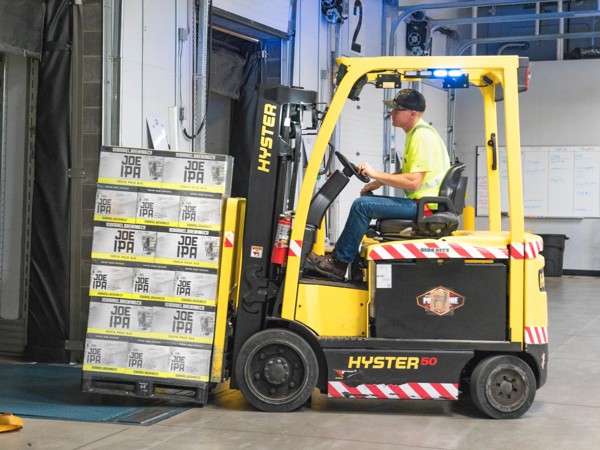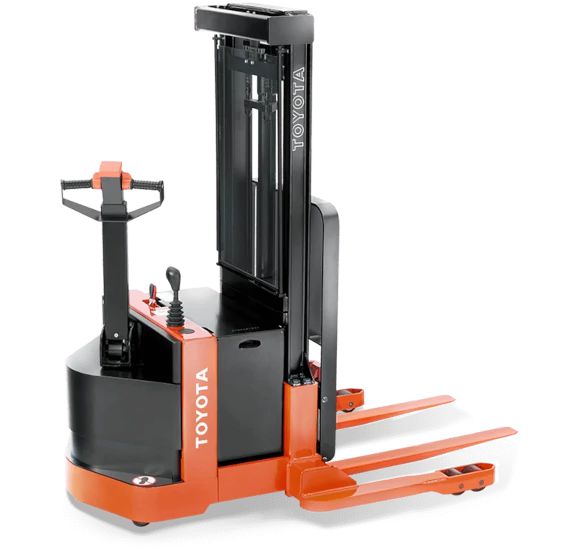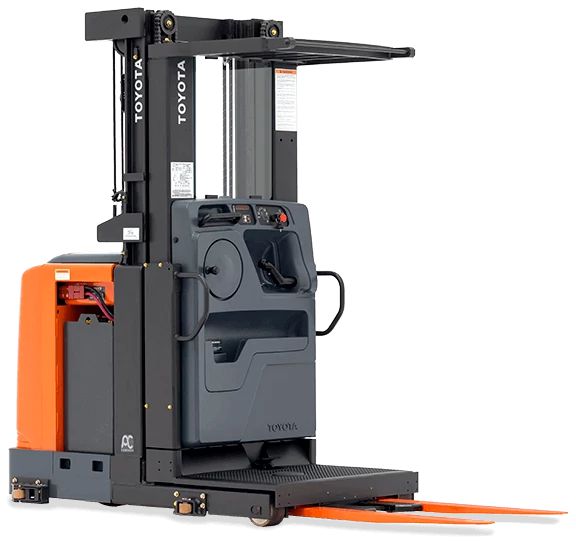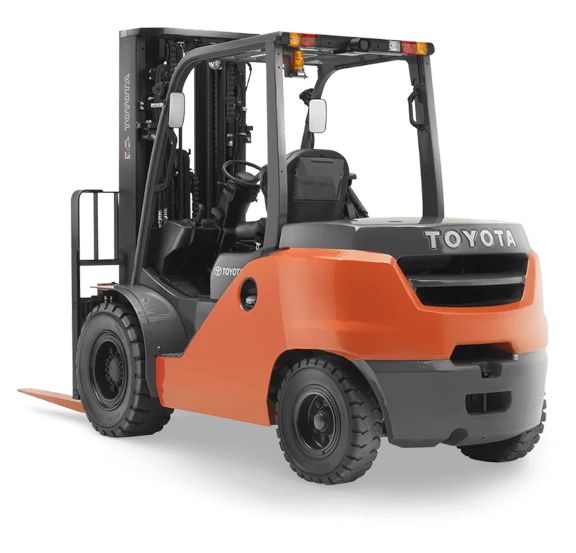8 Types of Forklifts Used In Warehouse Operations & Construction
July 3, 2021
Forklifts are a common type of equipment found at most industrial warehouses and construction sites. Forklifts enable operators to move pallets and materials quickly and efficiently.

Forklifts (also known as lift trucks, jitneys, forklift trucks and powered industrial trucks "PITs") are a common piece of equipment used by many industries and construction sites to move and manage materials.
Forklifts are very useful and can help with a wide range of applications - they can raise, lower, stack, organize, carry, push, pull and tier materials, crates, pallets, workers and more. Worldwide over one million forklifts are sold each year.
Forklifts are rated for loads at a specified maximum weight and a specified forward center of gravity. Manufacturers measure and test forklifts and designate these specs to protect operators from accidents and rollovers.
Most warehouse forklifts have load capacities between one and five tons. Some larger forklifts can lift up to 50 tons (these are meant for heavier industrial applications such as shipping containers).
Powered forklifts use an energy source and can be ridden or controlled by a walking operator. In the United States, Occupational Safety and Health Administration (OSHA) regulates the use of powered forklifts and mandates operators must be at least 18 years old. In addition, OSHA requires forklift operators to complete training certification every three years.
Forklift Power Sources
Most forklifts have a power source to do the heavy lifting and maneuvering. Common power sources include:
- Liquid propane gas (LPG): Most forklifts use 33 lb cylinders of liquid propane gas. Propane is common, cheap and burns clean. LPG forklifts can be used indoors because they operate quietly and do not release high amounts of harmful emissions. LPG tanks are typically mounted on the rear of the truck and are designed to enable quick changing.
- Diesel: Diesel forklifts offer more power and lift capacity than LP forklifts, and they are better suited for outdoor applications because diesel emissions require constant ventilation. Diesel engines also tend to be noisier.
- Electric: Electric forklifts are very quiet and produce no harmful emissions. They are better suited for indoor applications. Batteries types include lead-acid (similar to most automotive batteries) and lithium-ion. Some industries such as food processing and healthcare require electric forklifts for safety reasons.
Forklift Tires
Common tires for forklifts include cushion tires (solid rubber) and pneumatic tires (air-filled). Cushion tires work best on solid, flat surfaces. Cushion tires are less susceptible to punctures from sharp objects because they are solid rubber (a bonus in warehouses that might have nails and other sharp objects on the floor). Pneumatic tires can handle larger loads and operate smoother on uneven surfaces.
Cushion tire forklifts generally operate closer to the ground, which limits their application coverage. Cushion tires are usually cheaper than pneumatic tires.
Rough terrain forklifts are designed for outdoor use on uneven surfaces. Their tires are often much larger and have more gripping traction (they look similar to heavy construction and farm equipment tires). Some rough terrain forklifts have stabilizers to provide additional stability support.
Common Types of Forklifts
Eight common types of forklifts are listed below. All of the images are from Toyota Forklifts, with the exception of the rough terrain forklift, which is from Case Construction.
Warehouse Forklift

Warehouse forklifts are the typical forklifts people visualize when they hear the word forklift. Warehouse forklifts are used for common warehouse functions, including stocking orders, lifting equipment and people, moving materials, stacking materials, and more.
Most warehouse forklifts are designed to handle up to 5,000 lbs load on average, and some heavy-duty models can handle up to 20,000 lbs payloads.
Pallet Jack

Pallet jacks, also known as pallet trucks, pallet pumps, pump trucks, scooters, dogs, and jiggers, are a tool used to lift and move pallets. Pallet jacks are the simplest and most basic forklift design featuring two forks typically 20 1/4 inches or 27 inches wide. Their basic function is limited to moving pallets inside a warehouse.
Pallet jacks typically have steering wheels in the front, and each fork has either a single wheel or two bogie wheels. The pallet jack lifts pallets by inserting its forks underneath the pallet, then raising the forks using a hydraulic pump.
Most pallet jacks are designed to handle approximately 5,000 lbs on average, and some models are able to lift up to 8,000 lbs.
There are three common types of pallet jacks:
- Manual pallet jacks are hand-powered by the operator and used to lift, lower, and steer pallets from one place to another. Manual pallet jacks are typically very affordable because they feature a simple design with fewer moving parts and no engine. They are commonly used in retail and warehousing operations.
- Powered pallet jacks (also known as electric pallet trucks walkies and power jacks) are similar to manual pallet jacks in design, however, they feature an engine that allows lifting and moving of heavier and stacked pallets. Some powered pallet jacks feature a platform for the operator to stand upon while using it.
- Rough terrain pallet jacks are intended for use on uneven ground. They feature heavy-duty frames and pneumatic tires to accommodate a wider range of surface types.
Walkie Stacker

Walkie stackers are another simple design featuring a mast that enables lifting payloads to greater heights than pallet jacks. Walkie stackers are often said to be a fusion of a pallet jack and forklift - because they have a simple design and handle (similar to a pallet jack) while providing reach (similar to a forklift). Walkie stackers can be both manual or powered.
Operators typically guide and maneuver the walkie stacker around the warehouse by pulling the handle. Most walkie stackers are designed to handle between 2,000 and 3,000 lbs on average, with some models lifting up to 4,000 lbs. Lift heights vary based on make and model and typically range between 6 and 14 feet.
Variants of the walkie stacker include walkie straddle stackers, walkie reach stackers, counterbalance walkie stackers, and ride-on walkie stackers.
Order Picker (Stock Pickers)

Order pickers are designed to handle one or two units and an operator rather than lifting an entire pallet. Operators ride in a platform that raises and lowers them to different levels of warehouse racks. Order pickers help operators "pick their orders" inside warehouses — the operator uses the order picker to quickly and efficiently retrieve and store items at varying heights inside a warehouse.
Order pickers are very efficient and capable of maneuvering in narrow aisles. Capabilities vary based on make and model - most can handle loads between 300 lbs and 3,000 lbs, and some can reach a height of up to 32 feet.
Reach Fork Truck

Reach fork trucks provide operators the ability to reach into warehouse racks. Reach fork trucks feature outrigger legs and forward-extending forks to enable X and Y movement of the forks at heights up to 30 feet. Fork reach trucks are capable of lifting a pallet high into the air, and then extending the forks forward to place a pallet onto a rack. The ability to move the forks forward is the "reach" function.
Typically fork reach trucks can handle loads between 2,000 lbs and 5,000 lbs.
Rough Terrain Forklift

Rough terrain forklifts are built for high mobility and stability on uneven soil, rocks, sand and even soggy surfaces. Rough terrain forklifts are often used in applications such as docks, outdoor yards, special events, timber forestry, construction sites, farms and more. They tend to feature larger tires and engines (for more lifting capacity) and a reinforced cage cab to protect the operator.
Industrial Forklift (Large Capacity Forklift)

Industrial forklifts are capable of lifting much heavier loads than warehouse forklifts and telehandlers — they are capable of lifting over 30,000 lbs.
Counterbalance Forklift

Counterbalance forklifts feature a large counterweight in the rear of the vehicle to enable the lifting of heavier loads ("counterbalancing" the loads). Counterbalance forklift trucks are versatile and can be operated both indoors and outdoors. They are intended for flat and smooth surfaces.
Counterbalance forklifts have a large turning radius, so they are more limited in narrow aisles and closed spaces. Models can come in both a three and four-wheel design.
Forklift Attachments
Forklifts are designed for the use of various attachments to expand their capabilities. Common attachments include:
- Buckets: Used to enable the forklift to act similar to a mini loader.
- Fork extensions: Provide a longer reach by extending forks to lengths up to 96". The fork extensions slide over the existing forks, similar to a glove.
- Bale clamps: Fitted to a forklift mast in place of standard tynes and carriage. Bale clamps feature two hydraulic clamps that can grip both sides of baled products.
- Barrel clamps: Used for handling barrels, kegs and paper rolls. Some designs of barrel clamp attachments also have a rotate function.
- Crane hooks: Transform the forklift into a mobile crane, enabling it to handle loads using a "lifting from above" function.
- Spreader bars: Attaches to the front of a fork truck and stabilizes material that has the potential to bend when it is lifted. Spreader bars provide increased stability for large and oversized loads.
- Winches
Resources
Forklift tire guide by CongerForklift safety video by OSHA



